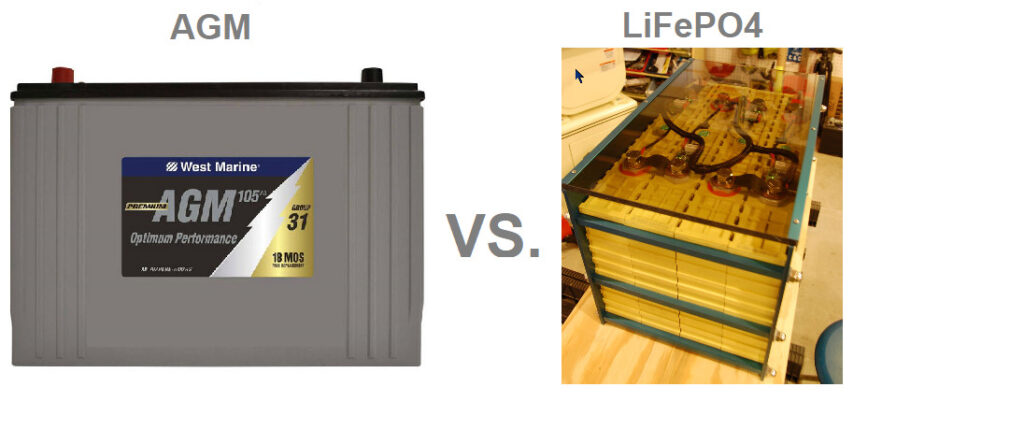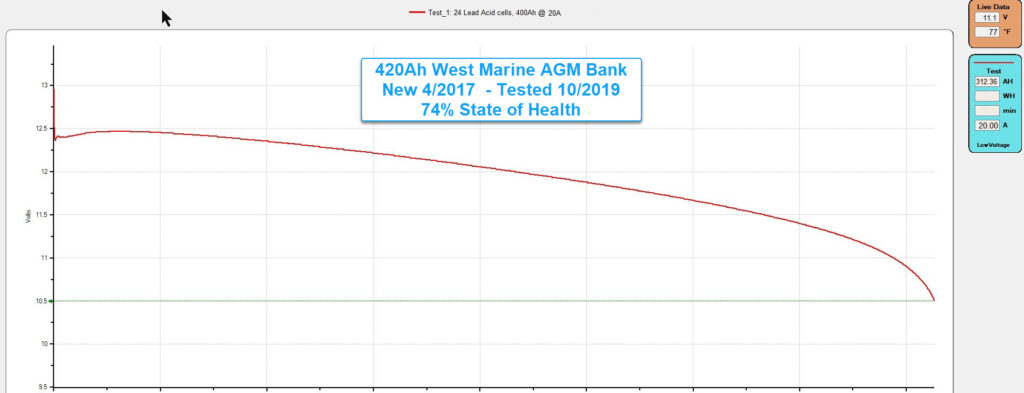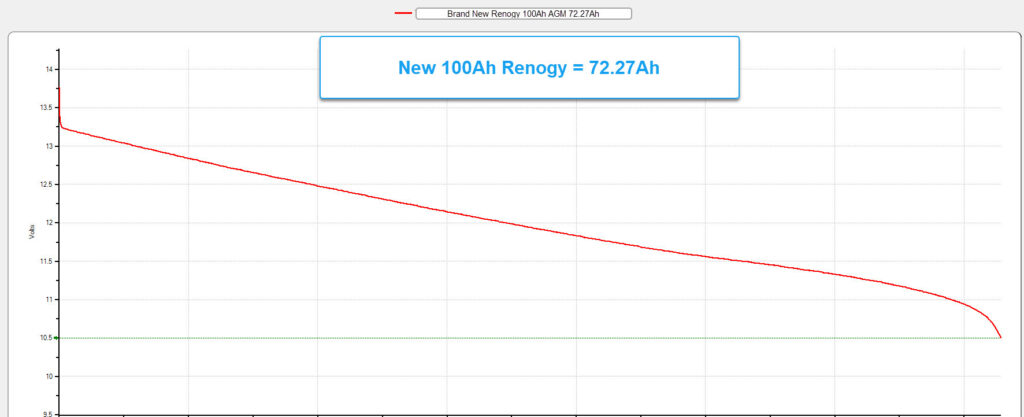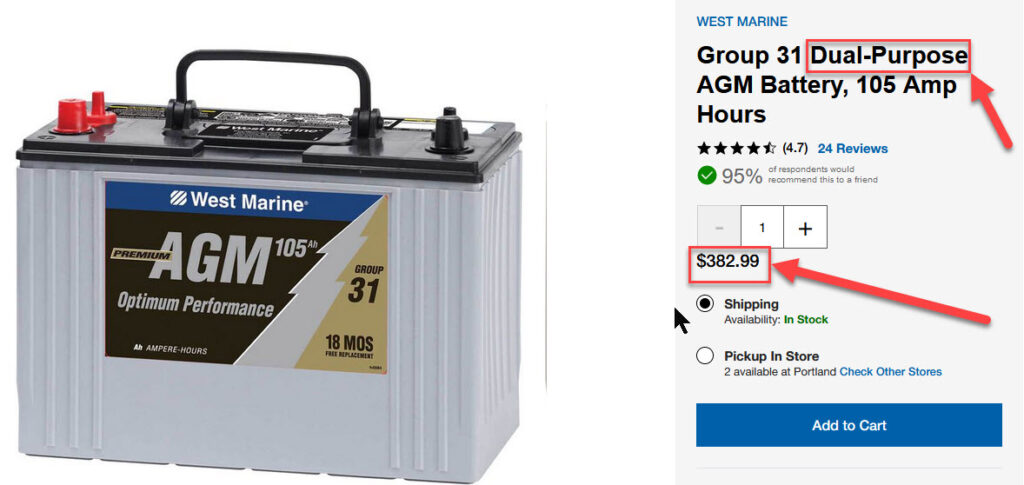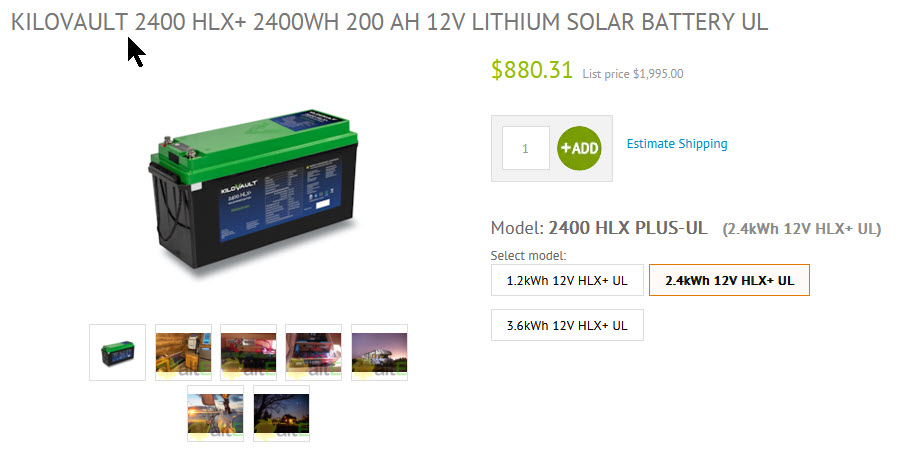AGM vs. LiFePO4
This short article takes a look at two real world use battery banks used on cruising boats, a 2.5 year old 420Ah rated AGM bank and a 13 year old 400Ah rated LiFePo4 bank.
Definitions Used:
SoC = State of Charge
DoD = Depth of Discharge
PSoC = Partial State of Charge
LFP= Abbreviation for LiFePO4
BCI= Battery Council International
Ah= Ampere Hour
The discharge plot below was four West Marine 105Ah AGM Batteries that were purchased in April of 2017. They were tested in October of 2019. While we rarely test entire banks all at once but, this customer specifically wanted to know the bank capacity and testing each battery individually is a lot more expensive. So, we tested his four West Marine 105Ah AGM batteries as a parallel 12V bank. The owner estimated approx 50 cycles to 50% SoC based on his use of the boat.
We knew that even when brand new these batteries have a tough time delivering the 105 Ah rating (420Ah rated bank) so we called the bank 400Ah in the testing software. Technically we should have used 420Ah but the 400Ah calculation gives these batteries a slight edge as the 20 hour discharge rate should really be 21A not 20A.
The batteries were tested to BCI standards at the 20 hour rating of 20A for the four 100Ah batteries in parallel. To find the 20 hour discharge rate you simply divide the 20 hour Ah capacity by 20 or; 105Ah ÷ 20h = 5A x4 (in parallel) = 21A discharge rate. For BCI testing the battery needs to be between 77F and 80F and then discharged under a constant current at the 20 hour discharge rate to a cut-off voltage of 10.5V. To hold temp at 77F we use a temp controlled water-bath as I don’t want to keep the shop at 77F..
As can be seen this 2.5 year old very expensive ($1532.00) 420 Ah rated AGM bank can only muster a paltry 74% state of health. It should be noted that this boat had a 140W Kyocera solar panel and a Morningstar MPPT controller for full recharges while on the mooring. The alternator was the stock Yanmar 80A which is less than ideal but “real-world“. The boat also had a Magnum 2000W inverter/charger for when the boat was dockside. The magnum and Morningstar both had temp sensors installed.
IMPORTANT: A deep-cycle battery that cannot deliver 80% of its labeled Ah rating is considered failed /end of life. This bank failed in just 2.5 years
The test results here are not alt all surprising to us as capacity testing batteries was service we offered our customers.
MHT Recommended LFP Batteries?
Our current favorite = Epoch
The Epoch Batteries offer Amazing construction, a 1.2C BMS, built in heating ,built-in bluetooth BMS (one of the best we’ve seen), waterproof, CAN communication, remote display/alarm exceeds ABYC.Cell compression, even the BMS is made by them not an off-the-shelf product. All this at a price that can’t be beat and an 11 year warranty! Our fried Ben @ Panbo did an excellent Epoch review .
Panbo Epoch Review
Currently Epoch is the price/value/feature leader for drop in batteries. Epoch batteries are built by RoyPow one of the best manufacturers in China. RoyPow is a division of EVE. Eve is one of the largest LiFePo4 cell makers in China. This is how they have such amazing cell to cell consistency, they get true EV/automotive grade cells.
EPOCH 10% DISCOUNT:
We have secured a 10% Epoch discount for MHT readers. Please Email us for the coupon code: compassmarineservices at gmail dot com
Buy Epoch Batteries- Epoch Batteries
Below we have Included Li Time batteries (formerly Ampere time) because they are the #1 selling LFP battery on Amazon. These batteries ship directly from the manufacturer but, they have been pretty responsive on the customer service front. This is not something we can say about too many inexpensive LFP batteries on Amazon. These batteries are an excellent value but they do lack important features that are found on the slightly more expensive Epoch & Kilovault batteries…. If your budget is tight it’s hard to beat Li Time.
Buy Penny Saver Drop-In Batteries- Amazon
The LFP Bank
This was my own personal bank that I built in 2009 and began using in the spring of 2010. This bank was built as an educational /experimentation tool for myself and our employees. As such, each cycle was carefully recorded and documented. I specifically ran each discharge to 80% DoD, occasionally 0% if needed. I also ran full 0% SoC capacity tests every 50 cycles. Once the bank broke 1000 80% DoD cycles I switched to capacity testing every 100 cycles (capacity just was not changing enough in 50 cycles to waste the time/energy).. At the time of testing this bank had just turned 13 years old and had exceeded 2200 cycles. It served summers (April to Nov) on our 36ft cruising sailboat and it spent winters as the “load bank” for our alternator test bench and also powered a large 2000W Inverter /charger in the shop that we ran an electric heater from…. This meant the battery was often sitting at 80% DoD or lower to serve as the load for alternators as large as 200A.
Why did I choose this bank?
#1 Because I don’t know of any LFP battery that is older than this or that has been as well documented. If anyone can find me an older LFP battery than this please forward it on.
#2 Because this bank was built well before we really knew much about LFP
#3 Because I personally used and tested this battery in a manner that would have killed any lead acid battery in a few short months
For the cells 14th birthday I tested each 400Ah cell individually
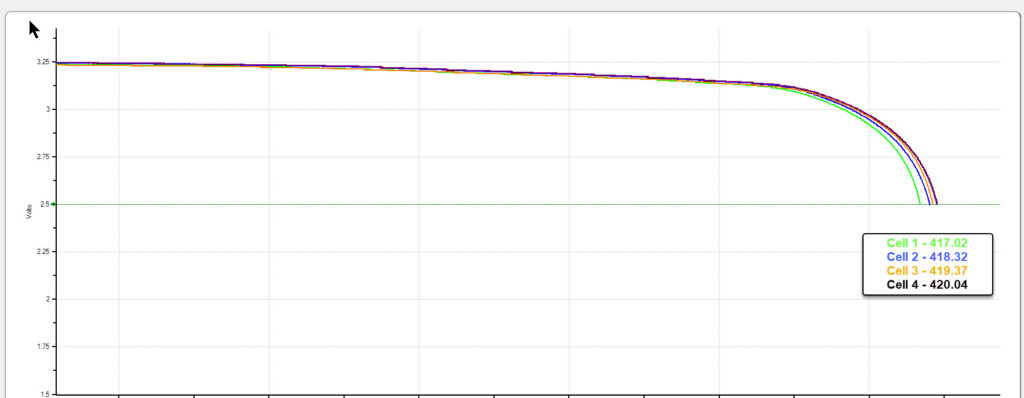 As can be seen the lowest capacity cell was 417.02 Ah. With LFP banks the lowest capacity cell determines bank capacity as this cell will cause the entire bank to disconnect the minute it his the low voltage cut off. For 13 year old cells the Ah capacity still matches to within 3Ah..It was slightly tighter when new but not bad for 13 years old and in excess of 2000 cycles!
As can be seen the lowest capacity cell was 417.02 Ah. With LFP banks the lowest capacity cell determines bank capacity as this cell will cause the entire bank to disconnect the minute it his the low voltage cut off. For 13 year old cells the Ah capacity still matches to within 3Ah..It was slightly tighter when new but not bad for 13 years old and in excess of 2000 cycles!
AGM Quality Matters
If you buy AGM’s only buy quality AGM batteries such as Lifeline, Odyssey, Northstar, Fullriver, Rolls or Victron Super-cycle. The only one on this list that we don’t have extesive data on is the Victron Superr Cycle. That said the testing we have done suggests they perform well for AGM’s. If you value your money never buy AGM batteries off Amazon unless it’s an above listed brand. They are typically made in Vietnam, or China and the quality is worse than the East Penn made West Marine AGM’s.
I know many uneducated battery buyers buy Renogy thinking all AGM’s are the same. Nothing could be further from the truth.
This new Renogy 100Ah battery, only a few cycles, was brought to us by a boat owner who suspected something wrong. We tested this battery to BCI testing standards. The battery was charged to 1oo% in our lab, warmed to 77F (temp controlled water-bath), allowed to rest for 24 hours then a 5A constant load was applied and the battery was discharged to a 10.5V cut off. The battery could only deliver 72.27Ah. The customer states;
“I finally gave up on a warranty replacement, Renogy customer service is awful.”
Why would I buy AGM?
A smart person capable of basic math would not buy AGM batteries at this point in time.
1- They don’t hold up to PSoC use.
2-They have poor charge efficiency (though better than Flooded deep-cycle)
3-They have less usable Ah’s than LiFePO4
4- They are far more costly than LiFePO4
LFP has come down in price to the point that they are less expensive than AGM.
Basic math:
First, I will point out that at least West Marine is not misrepresenting these batteries as “deep cycle”. They are not a deep-cycle battery and this is why they perform so poorly. Second, a 420Ah bank, with only 210 usable Ah’s will set you back a cool $1559.96 and last you just 2 to 5 years depending on use. We know the bank above had just 50+/- cycles to 50% DoD and they failed capacity testing in just 2.5 years..
Compare that to the 200AhKilovault HLX+ a full featured top of the line LiFePo4 battery will cost you just $880.31. For a 400Ah Bank that would cost you $1760.62. However, it will deliver 5000 cycles to 80% DoD & gives you 320 usable Ah’s vs. just 210Ah for AGM. Unlike Lead Acid you can discharge LFP batteries to 0% SoC, or 400 Usable Ah’s and still get 2000 cycles!
Consider the AGM bank in this article delivered approx 50+/- deep cycles to 50% DoD and survived 2.5 years before it “technically failed“. My own LFP bank is coming up on 14 years old this May and can still exceed rated capacity with more than 2000 cycles on it. The math is clear unless, you went to public school (wink).
Do the math and invest smartly!!! AGM’s are a complete waste of your hard earned money these days!

